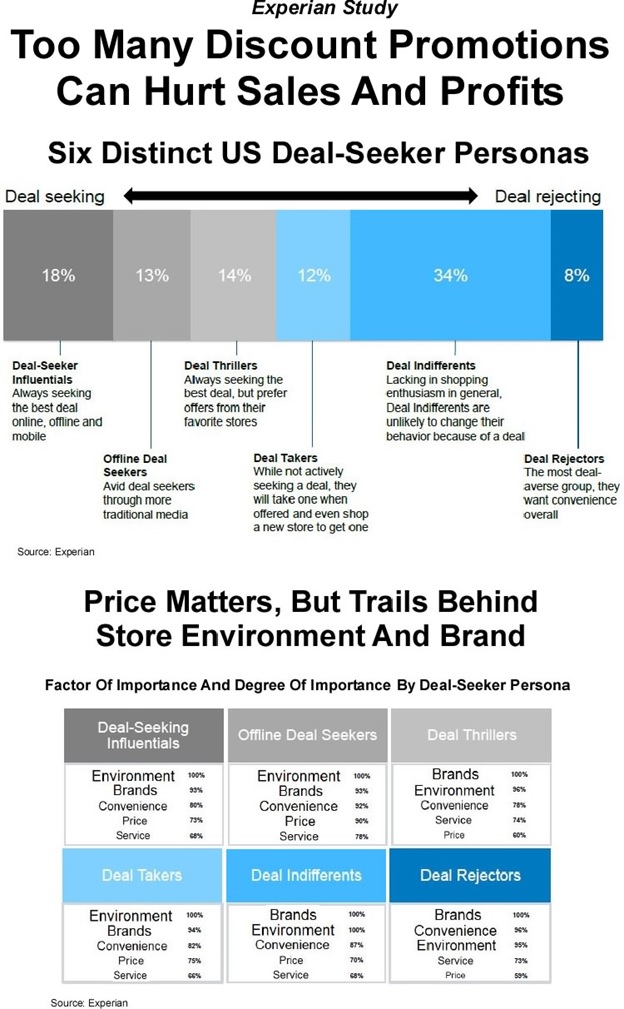By Ken Krivacic, OD, MBA

March 7, 2018
The last patient you saw is asking your optician for a discount, or they say they will buy their glasses elsewhere. What do you do? Another patient says they don’t feel like they should pay a contact lenses fitting fee because their contacts are “fitting” fine, and they just want more lenses. What do you do?
Do these scenarios sound familiar? Discounts can be something you have to deal with daily, yet they are not only found in our industry, but in every industry that is selling a product or service.
If used properly and judiciously, discounts can help build a practice or business. If overused, or if discounts become the norm, they can severely cut into profits and cripple a practice or business.
The Associated Press recently published an article entitled “No Deal on Discounts” by Joyce Rosenberg. In the article, the author cites the example of Mark Aseltine, who started online wine retailer Uncorked Ventures. As a new business, he felt he needed to offer a 30 percent discount to people buying wine baskets or monthly subscriptions. After analyzing sales, he sensed the deal didn’t really help, and that people who wanted top-of-the-line wine were turned off by the discount. So, last year Aseltine decided to end the discounts except for 10 percent off on Thanksgiving weekend. His revenue rose 20 percent from the previous year, and his more expensive wines sold better than when they were discounted.
Most independents can be considered small businesses. We don’t have the large volume of sales and inventory that big-box chain stores have. We should take heed of what other small businesses are doing when it comes to discounts. There are four lessons we can learn from Rosenberg’s article:
Lesson #1: Markdowns Don’t Motivate People to Shop
Think about your own practice. Do most patients come to you because you offer big discounts? Most patients come to us as small, independent practices because they will have a more personal experience, or because they are loyal to your brand. Experian conducted a study in 2014 that shows price to be at least the fourth, or fifth, factor in making a purchase following environment, brands, convenience and service. Below is a graphic of the results of the study.

Lesson #2: We Don’t Have the Sales Volume to Discount Without Hurting Earnings
If your business model is to have a large volume of low-cost frames, and discount them continually, this may work. For most of us that is not possible. We don’t have the space for that many frames or contact lenses, and we don’t want to tie up dollars sitting in inventory. The other negative is that if you are constantly offering discounts, you may be turning your patients into low-cost buyers.
In our practice, in the contact lens department, we offer reasonable prices (slightly above what 1-800 offers) and we stick to that price. There are other online retailers that offer what look like unbelievably low prices, but we will not price match. We have found that, after the patient has gone through the buying process at those retailers, other fees are added at the end of the purchase that significantly increase the price to the patient, and the deal is not quite the deal they thought they were getting.

An ad from Dr. Krivacic’s practice offering 15 percent off sunglasses. Such discounts can be useful, but only when used judiciously and sparingly, Dr. Krivacic says.
Lesson #3: Price-Slashing Lessens the Appeal of Your Practice
Most patients come to us because we are independent practices, and they are expecting a certain level of customer service and personal attention. They don’t come to us because our fees are the lowest in town. Elaine Kwon, an online retail consultant says, “The customer is debating between a brand they love that’s full price and a brand giving them a discount. Shoppers may forego the discounts if they believe they’re getting good value, even at full price.” Make your practice attractive to your patients in other ways such as the physical environment, convenient hours, a friendly and knowledgeable staff and the brands of products you carry. Do all those things, and price becomes a secondary consideration.
Lesson #4: Avoid Cat-and-Mouse Games, Continually Lowering Prices Until Patients Buy
We all know this trick – mark a product up three times, so that 50 percent off sounds really good. Do you really want to play that game? Is that the type of patient you want purchasing in your practice? Will they purchase from you again next year unless you offer a discount? Our practice has focused on making sure the patient has a great experience and will return year after year. Patients looking for the big discount can always find someone else offering a slightly better discount. Why play that game and reduce your revenues at the same time?
Do This Instead
In general, any business, including optometric practices, should use discounts sparingly. The revenue-to-expense ratio is the key to profits and staying in business. Are there times when discounts make sense? There can be, but be careful. The American Management Association has these tips for when discounts might be appropriate:
Move Excess or Old Merchandise. If you over-ordered, or over-produced, certain products, a discount could move them quickly. Items about to become obsolete, or go out of style, need to be moved out before they become un-sellable. Less money is better than no money.
Seasonal Sales. A discount on seasonable products can greatly increase sales when the selling season for those products is just starting or almost over. Keeping leftover products until the next year is risky because styles might change or new innovations may be introduced.
New Products. Introductory lower prices will start word-of-mouth advertising in motion to spread the new idea to other customers quickly.
Larger-Quantity Orders. A common practice in business-to-business sales is buy more/save more. Some type of discount should also be offered to consumers who purchase larger quantities of an item than the average buyer.
Senior Citizens & Students. Special-interest groups can build more volume and bring public awareness and goodwill to your business. Discounts will encourage them to tell their friends and send referrals.
Perishable Items. Selling at reduced prices is better than disposing of items whose shelf life or expiration date is nearing the end. Some return is always preferable to a loss.
Break Into a New Market. When you discover a new target market for your products or services, lower prices can help you acquire new customers quickly. This will give you a chance to see how you’re being received in these uncharted waters.
Build Volume. You may want to increase volume and sales, so you can take advantage of volume discounts from your suppliers. If you’re thinking about selling the business, higher sales figures may make the company more attractive to potential purchasers. The discounts will also serve as a temporary bonus for your regular customers.
Capture the Visitor Market. A retail business can go after some of the out-of-town visitors who travel through your area. Advertise your discount where they will see it, in tourist guides, newspapers, etc.
Increase Cash. When your cash flow needs a boost, and you have a lot of product on hand, discounts can be a productive tool. Lower prices may also draw in a few new customers who may want to try your company, and will make a first purchase at a lower price.
Loss Leader. Products can be discounted to cost, or a even a bit below cost, to bring customers in. Hopefully they’ll also purchase other, more profitable, items.
Advertising Strategy. Discounts will draw more attention to a new ad campaign, adding to its success.
Point-of-Sale. When a customer is on the verge of buying, but needs a nudge, a small discount may provide the extra incentive he needs to do it now. A lower price to upgrade or add additional products can also increase sales.
Solve a Customer Problem. If an order was shipped incorrectly, but the customer can still use the merchandise, a discount can often smooth over the situation. It may be better to make a smaller profit, or break even, than to inconvenience—and possibly lose—a customer.
 Ken Krivacic, OD, MBA, owns Las Colinas Vision Center in Irving, Texas. To contact him: kkrivacic@aol.com.
Ken Krivacic, OD, MBA, owns Las Colinas Vision Center in Irving, Texas. To contact him: kkrivacic@aol.com.



























